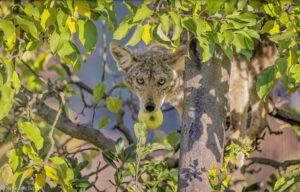Clementine is a 130-pound great Pyrenees—a white shag carpet of a dog who sleeps through the day out in the rolling hills of West Marin, guarding up to 1,500 head of sheep owned by Bill Jensen. Jensen lives on 240 acres near Tomales, at the end of a road named after his great-great-grandfather, who settled here in the 1850s. Jensen’s family has raised sheep for nearly a century, but they never owned guard dogs because coyotes weren’t killing their livestock. Now two dogs guard his herd, thanks to a unique program aimed at controlling coyotes without killing them.
It wasn’t until the early 1980s that coyotes reappeared in Marin, after being extirpated by early settlers over a century before. By the time coyotes returned, the only predation ranchers were dealing with was the occasional loss of a lamb to raptors or mountain lions. The arrival of coyotes created a direct conflict between two things that have come to define West Marin: small-scale local agriculture and protected open space and wildlife.
From the 1920s to the 1970s, North American coyote populations were subject to broadcast poisoning with strychnine-laced animal carcasses. Public pressure ended that practice, and coyotes began to repopulate areas, like Marin, from which they had been driven out. At the same time, local governments began hiring trappers to hunt, trap, and selectively poison “nuisance animals.” That is still standard procedure for 39 California counties, including Sonoma, Alameda, and Contra Costa.
- Rancher Bill Jensen and activist Camilla Fox on Jensen’s West Marin ranch. Photo courtesy Camilla Fox.
In Marin, the county began trapping and killing local coyotes. But indiscriminate use of traps and controversial poisons elicited protests from citizens—organized in large part by Larkspur resident Camilla Fox, former director of wildlife programs at the nonprofit Animal Protection Institute. In response, the county started a new program, the only one like it in the nation, that relies solely on nonlethal measures—guard dogs and llamas, electrified fencing, and outdoor alarms.
Until 1999, Marin was spending $60,000 annually on lethal control. But it didn’t work. In the final year of trapping, more than 100 animals were killed, but most were badgers, bobcats, and foxes, none of which threaten livestock.
Now, the county splits the cost of nonlethal measures and reimburses ranchers for losses of up to 5 percent of a herd. In all, 18 ranchers participate in the program, representing 7,500 of the county’s 10,000 sheep. Over six years, says Marin Agricultural Commissioner Stacy Carlsen, losses have fallen to 2.2 percent—and the program costs over $10,000 a year less than the old one.
It turns out that lethal controls can be counterproductive. Coyotes form territorial alpha pairs that do most of the hunting and all of the mating in an area. Beta coyotes roam and don’t breed until they find a home territory. Dale McCullough, a retired UC Berkeley wildlife biology professor, says coyotes are smart enough not to be caught twice (if they escape the first time), and they’re very difficult to trap at all in their home territories. It’s much more common to capture roaming betas, who rarely kill livestock. At the same time, successful removal of an alpha can trigger breeding among nearby betas before a new territorial pair becomes dominant. The juveniles born of that event are forced to roam farther for territory, often into environments rich in livestock, trash, and wayward pets.
Coyotes typically subsist on rodents, insects, and some wild plants, but they will eat just about anything and can adapt to very urban environments, even San Francisco’s Golden Gate Park.
“Coyote coexistence programs, in both agricultural and urban areas, should maintain resident coyotes, and keep them at arm’s length by [avoiding] unintentional feeding,” says Fox. Five years of data from Marin is bearing that out.
“For the first couple of years we couldn’t tell if the [loss] reductions were a trend or a blip. Now, we can say there’s a pattern,” says Carlsen. “In a few years we’ll be a model without anybody questioning our success.”
Jensen says the program is helping his ranch remain viable. “I don’t care if there’s a million coyotes out there,” he says, “as long as they don’t kill my sheep and I can stay on my land.”
To learn more about the Animal Protection Institute, go to www.api4animals.org.

.jpg)




